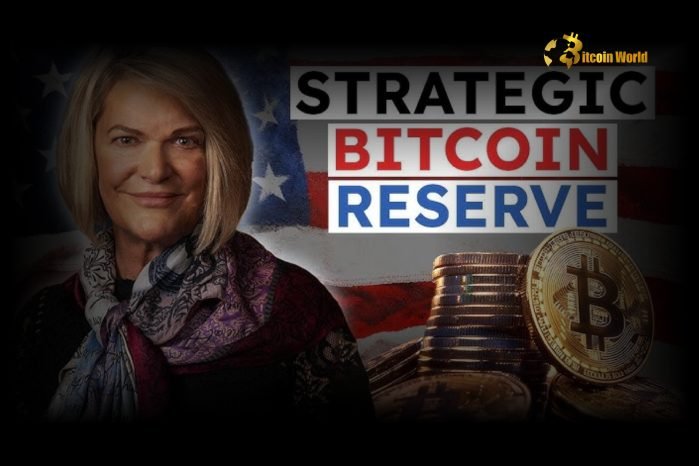Representative Cynthia Lummis, the newly confirmed Chairperson of the Digital Asset Subcommittee, has made an urgent plea for Congress to pass a bipartisan bill that establishes a strategic Bitcoin reserve and a comprehensive regulatory framework for digital assets. In a statement posted on her X account, Lummis emphasized the need for the U.S. to embrace digital assets to maintain its position as a global leader in financial innovation.
Lummis stated that she is committed to submitting the proposed legislation to President Donald Trump by the end of the year, highlighting its importance in strengthening the U.S. dollar and securing the future of American finance.
To learn more about the innovative startups shaping the future of the crypto industry, explore our article on the latest news, where we delve into the most promising ventures and their potential.
Key Points of Lummis’s Proposal
- Strategic Bitcoin Reserve
- The bill aims to establish a national Bitcoin reserve to enhance the U.S. dollar’s stability and competitiveness in the global financial system.
- Comprehensive Regulation
- Lummis calls for a clear and comprehensive regulatory framework for digital assets to provide clarity for businesses and investors.
- Bipartisan Collaboration
- Lummis stressed the importance of bipartisan support to ensure the bill’s swift passage and implementation.
Why a Bitcoin Strategic Reserve is Important
- Strengthening the U.S. Dollar
- Incorporating Bitcoin into a strategic reserve would reinforce the dollar’s role as the world’s reserve currency by integrating a deflationary, decentralized asset.
- Global Competitiveness
- Nations like China are advancing their digital currency initiatives. A Bitcoin reserve would help the U.S. stay ahead in the global race for financial innovation.
- Economic Stability
- Bitcoin’s limited supply makes it an effective hedge against inflation and fiat currency devaluation.
Lummis’s Vision for Digital Assets in the U.S.
Representative Lummis, a long-time advocate for cryptocurrency, envisions a future where digital assets play a central role in the U.S. economy:
- Financial Innovation: Lummis believes that embracing blockchain and digital assets will drive innovation and secure America’s financial leadership.
- Investor Protection: A regulatory framework will safeguard investors while fostering innovation in the cryptocurrency space.
- Economic Growth: By supporting the digital asset industry, the U.S. could attract investment and create new economic opportunities.
Challenges in Passing the Bitcoin Strategic Reserve Bill
- Political Divisions
- Achieving bipartisan support for cryptocurrency legislation remains a challenge due to differing views on digital assets.
- Regulatory Complexity
- Developing a comprehensive framework that balances innovation and investor protection is a complex task.
- Public Skepticism
- Educating the public about the benefits of a Bitcoin reserve is essential to overcoming skepticism and building support.
Global Implications of a U.S. Bitcoin Reserve
If passed, the Bitcoin Strategic Reserve Bill would have far-reaching implications:
- Setting a Global Precedent
- The U.S. would be the first major economy to establish a national Bitcoin reserve, influencing other nations to follow suit.
- Driving Institutional Adoption
- A national reserve would legitimize Bitcoin, encouraging further institutional investment and integration into traditional finance.
- Enhancing Geopolitical Influence
- By leading the charge in digital assets, the U.S. could strengthen its geopolitical position in the evolving global economy.
Conclusion
Representative Cynthia Lummis’s call for a Bitcoin Strategic Reserve Bill reflects the growing recognition of digital assets as essential to the future of global finance. By advocating for a bipartisan approach, Lummis aims to secure America’s financial leadership in an increasingly digital world.
While challenges remain, the passage of this bill would set a significant precedent, positioning the U.S. as a pioneer in integrating cryptocurrencies into its national economic strategy. With Congress’s support, the proposed legislation could mark a pivotal moment in the evolution of Bitcoin and digital assets as mainstream financial instruments.
To learn more about the innovative startups shaping the future of the crypto industry, explore our article on the latest news, where we delve into the most promising ventures and their potential.
FAQs
What is Cynthia Lummis’s Bitcoin Strategic Reserve Bill?
The bill proposes establishing a national Bitcoin reserve and creating a comprehensive regulatory framework for digital assets to strengthen the U.S. economy.
Why is a Bitcoin reserve important?
A Bitcoin reserve would enhance the U.S. dollar’s stability, hedge against inflation, and ensure global competitiveness in financial innovation.
What role does Congress play in the Bitcoin reserve bill?
Congress must pass the bipartisan legislation to establish the reserve and provide regulatory clarity for digital assets.
What challenges could the bill face?
Challenges include political divisions, regulatory complexity, and public skepticism about cryptocurrency adoption.
How would the bill impact the U.S.’s global position?
The U.S. would set a global precedent, driving institutional adoption of Bitcoin and solidifying its leadership in financial innovation.
What is Cynthia Lummis’s vision for digital assets?
Lummis envisions a future where digital assets drive financial innovation, protect investors, and contribute to economic growth in the U.S.
To learn more about the innovative startups shaping the future of the crypto industry, explore our article on latest news, where we delve into the most promising ventures and their potential to disrupt traditional industries.






